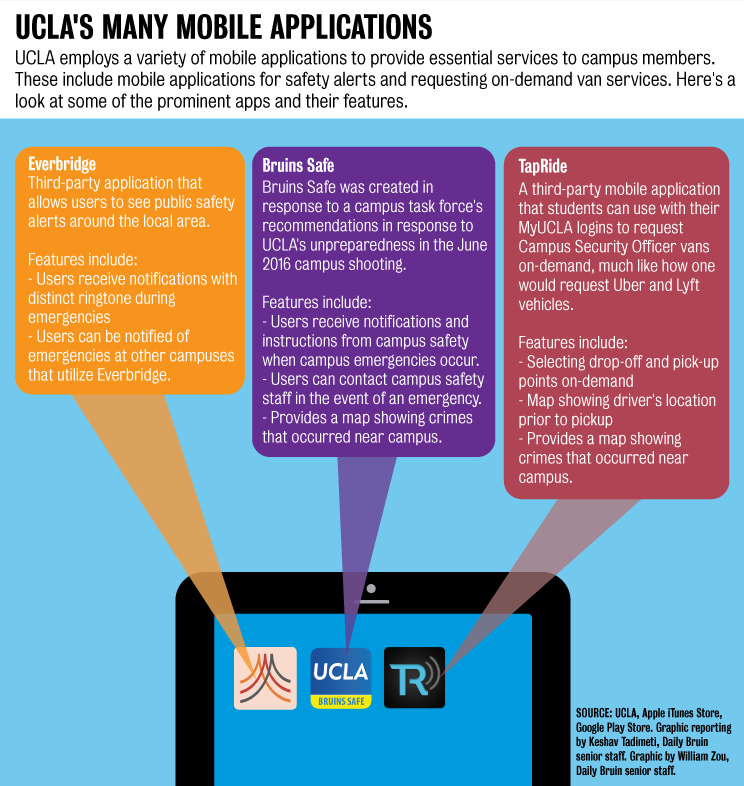William Bleveans: Surplus of Bruin alert programs creates confusion, wastes resources

By William Bleveans
Oct. 26, 2017 1:01 a.m.
Conventional wisdom holds that smartphone apps make our lives easier. But a confusing glut of apps and digital programs designed to enhance safety at UCLA has done the exact opposite.
UCLA offers three separate digital campus safety programs: Bruins Safe, BruinAlert and Bruins Safe Online. Each program supplies essential information about campus safety, yet none are widely used by UCLA’s student body. For example, Art Kirkland, the director of UCLA’s Office of Emergency Management, said Bruins Safe has only 7,000 registered users. Assuming that each student has downloaded the app only once, this means that less than one-sixth of all students are registered.
Students might be less likely to adopt these programs if there are too many of them. Maintaining numerous campus safety programs makes it difficult for each app to be adopted widely or be used at its full potential, raising the possibility that students will not be able to access critical information during a crisis.
The university must integrate the functions of each platform into a single comprehensive safety app to increase the number of students it protects and make its expansive campus safety program easier to navigate. A single app would be easier to promote to students and will be simpler to use, ensuring UCLA can better protect a large amount of students with the most intuitive software available.
It seems obvious that campus emergencies can be alleviated if enough students have access to campus safety apps. In fact, the Bureau of Justice Assistance, a federal agency that advises law enforcement, recommended as much, exhorting universities to ensure that as many students as possible sign up for digital campus safety programs.
Yet, the low number of students who have downloaded Bruins Safe and other programs suggests that UCLA has fallen short of the mark. In addition, conversations with ordinary students suggest that many are unaware of the various safety programs.
“The only app I know of is BruinAlert,” said Jose Davalos, a third-year biology student. “I’ve never heard of Bruins Safe.”
David Vasquez, a third-year architecture student, said he hadn’t heard of any of the programs.
Given the recent increase in mass shootings and other emergencies on American college campuses, it is more important than ever for UCLA to ensure the majority of the student body has access to reliable crisis information through a digital campus safety platform. The alternative is misinformation and a lack of crisis readiness.
The surplus of campus safety apps, however, may hinder this information dissemination. Administrative Vice Chancellor Michael Beck said Bruins Safe Online is designed to post more information than the regular Bruins Safe app in the event of an emergency, meaning students who use the app may be under-informed. Consolidating these platforms, on the other hand, would guarantee all students have comprehensive, up-to-date information on a possible crisis.
The apps also haven’t been well-promoted to the student body. The university’s strategies to promote Bruins Safe to students mostly entailed presentations at orientation sessions and campus-wide emails, both of which are low-cost pursuits, Beck said. UCLA could easily expand its promotional efforts if it only needed to market one app, as it would permit the university to focus its resources and not divide them between multiple apps.
Of course, bringing every campus safety function under one roof could lead to information overload, making it more difficult for students to access vital resources when they need them most, Beck added. But while this concern is legitimate, it shouldn’t stop the university from moving ahead and consolidating.
The process of integrating each campus safety resource into one app will inevitably cause extraneous or unnecessary functions to be removed in the interest of saving space. Bruins Safe, for instance, has a number of practically useless features such as a “personal safety toolbox” that includes a flashlight and a button to share the app with friends. Such features would presumably be removed if UCLA’s campus safety apps were ever consolidated.
Moreover, UCLA has the technical knowledge and the resources to create a comprehensive, easy-to-use campus safety app. It seems reasonable to assume that a university whose computer science department is ranked thirteenth nationally has a pool of tech talent to draw from in creating an app. In addition, Kirkland said UCLA spent $24,000 to create the Bruins Safe app. If the university can spend such a sum on a non-comprehensive safety app, it seems likely it can spend more on a comprehensive one.
Modern campus safety requires universities to offer a widespread, easy-to-use digital platform to disseminate information during an emergency. Consolidating the various safety programs into a comprehensive app would help UCLA measure up to this standard, as well as make the app easier to use and promote to students.
When it comes to campus safety apps, less is definitely more.


